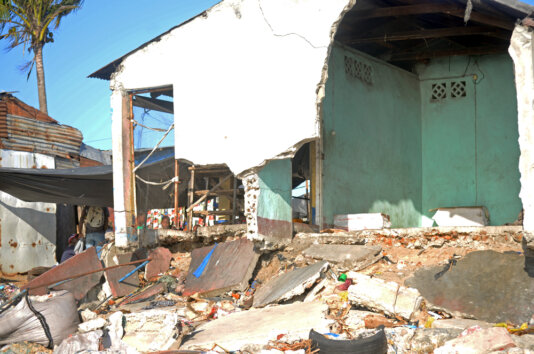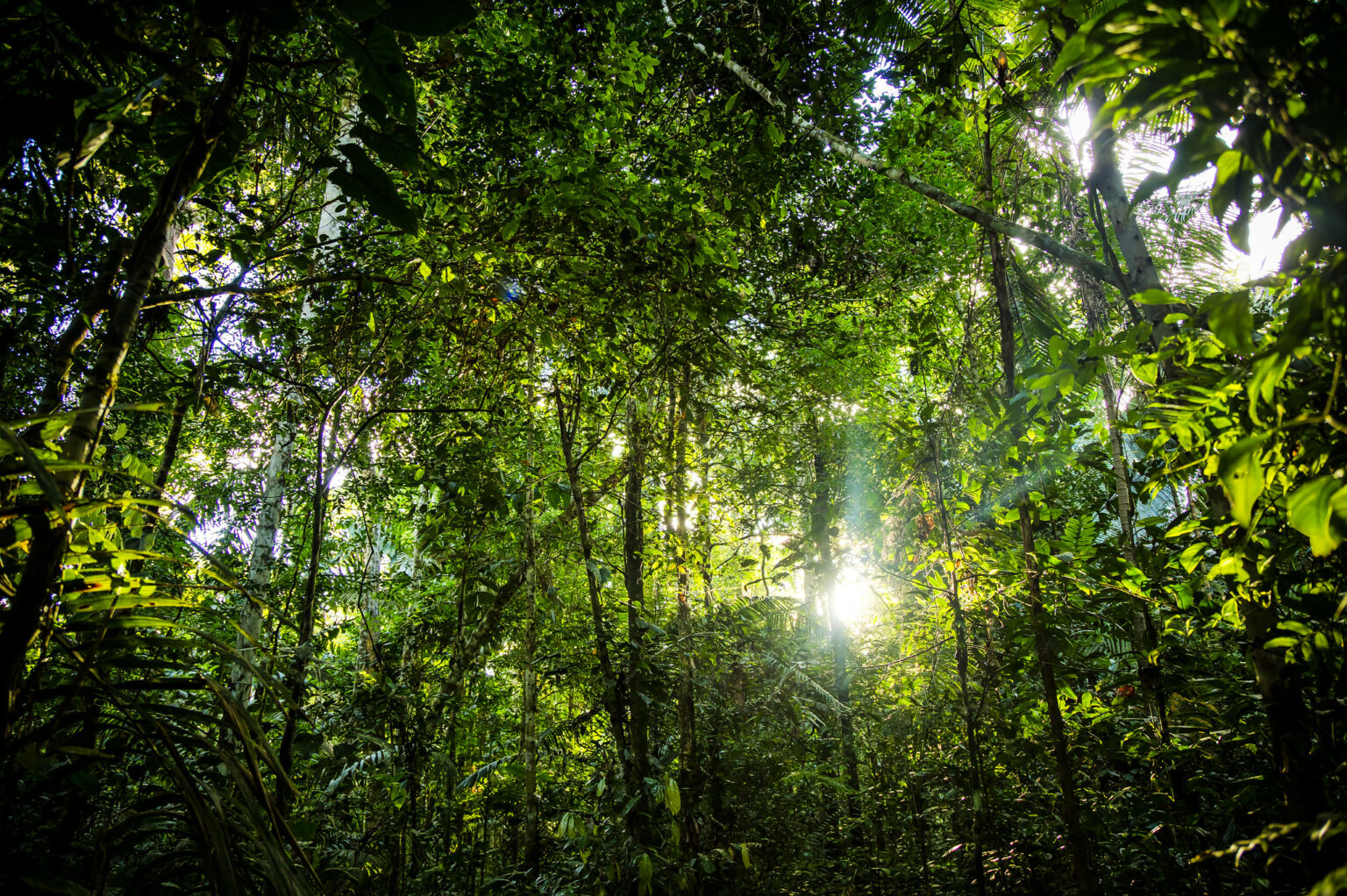- About
- Topics
- Picks
- Audio
- Story
- In-Depth
- Opinion
- News
- Donate
- Signup for our newsletterOur Editors' Best Picks.Send
Read, Debate: Engage.
| April 15, 2022 | |
|---|---|
| topic: | Conservation |
| tags: | #mangrove forests, #Mozambique, #marine wildlife |
| located: | Mozambique |
| by: | Andrew Mambondiyani |
On the outskirts of Beira, a coastal city in Mozambique, a house overlooking the Indian Ocean stands forlornly with a gaping hole.
The house, as many others in this part of the country, has been battered by violent storm surges and flooding.
As a result of climate change, tropical storms and cyclones are becoming frequent in Mozambique. In 2019, the country was ravaged by two devastating cyclones, Idai and Kenneth. This year, two tropical cyclones, Gombe and Ana, pummeled the country.
Against this backdrop, the Mozambican government and various organisations are working vigorously to make the country’s coastal communities resilient to the effects of global warming.
One such project is an ambitious mangrove reforestation, launched early this year by Mozambique’s Ministry of Sea, Inland Waters and Fisheries (MIMAIP) in partnership with Blue Forest, a new company based in the United Arab Emirates.
Mangroves are a group of trees - containing up to 80 different species - that grow in coastal areas at tropical and subtropical areas near the equator. And as part of the aggressive mangrove reforestation project in Mozambique, up to 100 million mangroves are to be planted on a total area of 185,000 hectares over the next 30 years.
The project, which will target Mozambique’s biodiversity-sensitive provinces of Sofala and Zambezia, is expected to offset approximately 200,000 tons of CO2 emissions annually - the equivalent of taking 50,000 cars off the road.
Crucially, the project will harness the power of new technology to identify key hot spots in coastal Mozambique where restoration is most needed.
In a statement following the launch of the project, Blue Forest said it would utilise high resolution satellite imagery, LiDAR technology and remote sensing data to identify mangrove hot spots.
According to experts, LiDAR technology can be deployed in various ways to manage forests, such as identifying areas that have been affected by human activities and taking measures to reduce environmental degradation.
"Artificial Intelligence (AI) algorithms will then be used to decipher the satellite data and field measurement to customise the reforestation activities in an accurate, efficient and transparent manner," Blue Forest said in a statement.
Blue Forest, an offshoot of Impact Adventures - a UK-based company delivering sustainable community-led projects in Africa, said they were big believers in innovation.
"Rather than just plant trees like the old days, we are constantly looking for new and innovative technologies and algorithms to increase the impact and efficiency of our reforestation efforts," the company noted.
Mangroves are critical as they protect coastal communities from erosion, tropical storms and cyclones. At the same time, the forests boost the flourishing of fish, shrimp and crab, which provide food and income sources for the local population.
But the country’s mangrove forests are facing serious threats from both human and natural causes.
"The threats, besides overuse of the wood for fuel and construction, is the overuse of agricultural chemicals which wash downstream and land up in these biological filters," Allan Schwarz, the founder of Mezimbite Forest Center, a community based programme in Mozambique, told FairPlanet.
Schwarz said that the worst of these was the use of defoliants and weed killers, which could kill not only the indicator mangrove species but a whole slew of microorganisms that the mangroves are dependent on.
"Then there are the standard N [nitrogen], P [phosphorous] and K [potassium] which in excess cause algae blooms which consume all the oxygen in the water and kill baby fish and crustaceans, as well as other algae which are toxic in themselves," Schwarz said.
He added that there was also a small industry cutting mangrove poles for construction in urban areas, and that the wood was quite unique for artisanal products.
However, Schwarz said, mangroves provide critical coastal protection for the entire country and have become ever more important with the rise of sea levels and the increase in both frequency and strength of cyclones caused by the confluence of global warming, local deforestation and pollution.
"They also form the habitat for the base of our fisheries, which is a big contributor to both food and livelihoods," he said.
Stephen Fadeyi, director of Water and Forestry at Blue Forest, echoed several of Schwarz’s claims regarding the qualities of mangroves, telling FairPlanet that mangrove forests provide social, environmental, ecological and economic benefits for Mozambique.
"[Mangrove forests] serve as a home for biodiversity [...] [and] a breeding or nesting ground for different aquatic life; improving and conserving the forest can help in improving food security," said Fadeyi.
He emphasised that mangroves also serve as a source of livelihood for local communities. "If the trees are harvested sustainably, they can provide power sources for cooking, materials for constructions and harvesting of aquatic organisms as a source of revenue," he said.
Fadeyi added that mangroves help in the filtering of sediments, suspended solids and impurities or pollutants that trickle downstream, thus protecting human lives and sensitive habitats such as the coral reefs.
"[Mangroves also serve as] protection or defense of the coastal area. The coastline of Mozambique experiences regular cyclones and turbulent water waves. The mangroves however help to reduce the wave strength thereby limiting the tendencies of coastal erosion and destruction of livelihoods or properties along the coastal line," he said.
At the same time, he said, mangroves provide a high level of carbon sequestration compared to terrestrial forests, a claim that is supported by a recent study.
"Mangroves absorb 2 to 4 times the CO2 compared to terrestrial forests. This will complement the effort of the government of Mozambique to reduce its carbon footprints," Fadeyi said.
The project would be financed by carbon credits generated through the reforestation and conservation activities over the 30-year period of the partnership.
Carbon credits are permits issued to allow polluting entities to continue to emit a certain amount of CO2 or other greenhouse gasses (one credit authorises the emission of one ton of a GHG). They are issued as part of the Cap and Trade regulatory program, which incentivises companies to ultimately reduce emissions by selling excess credits they do not need.
"The source of income for this project will be from carbon offset. The proceeds will be used for the development, investment and building of the communities," Fadeyi said.
Experts say that for a forestry carbon project to qualify as a verified emissions reduction enterprise and be deemed an offset, stringent rules must be met.
Fadeyi added that the mangrove project is a community-based one, as most of the restorations would be done through community help.
"[Community members] will be employed to implement the restoration and protection works. Since the project will be executed in phases, the estimated [amount of funding for the project] is unknown at this point," Fadeyi said.
Soon after launching the project, Xavier Munjovo, the permanent secretary of MIMAIP, said that Mozambique had over 300,000 hectares of mangroves along its coast, making it one of the largest tracts of mangrove forest in Africa.
"We are delighted to partner with Blue Forest and to introduce innovative technology in the way we map and restore our vital mangrove forests for generations to come," Munjovo said.
But Schwarz said he would consider it far more important to first tackle the root causes of destruction of mangrove forests before embarking on a restoration project.
"Growing mangroves is not that easy. Over the last ten years I have been working on the restoration of a landscape in Beira, which includes about 50 ha of mangroves," Schwarz said.
"I would be willing to assist the scientists and practitioners in this new initiative in showing them what I learned along with my dedicated crew," he added.
Image by Florida-guidebook via Unsplash.
By copying the embed code below, you agree to adhere to our republishing guidelines.


